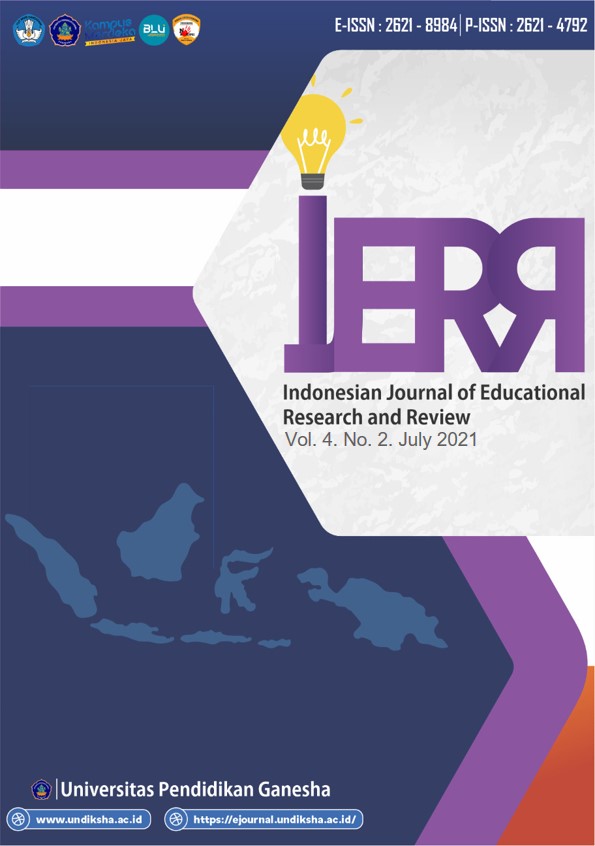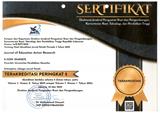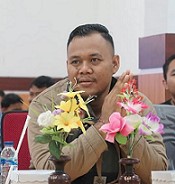Multimedia Interactive Learning on Indonesian Language Content
DOI:
https://doi.org/10.23887/ijerr.v4i2.39434Keywords:
Multimedia Pembelajaran Interaktif, Model ADDIE, Bahasa IndonesiaAbstract
The impact of covid-19, which requires all types of learning activities to be carried out online. As a result, teachers have limitations in finding learning media suitable for student characteristics and suitable for use in online learning conditions. The purpose of this development research was to determine the feasibility of designing interactive multimedia learning. This type of research is development research. The research model used is the ADDIE model. The subjects of this study were 3 grade III elementary school students. The data collection methods used were observation, interview and questionnaire methods. The product design test was carried out by several experts and students, learning material experts, learning design experts, instructional media experts, and individual trials consisting of three students. The form of data analysis used in this research was descriptive quantitative data analysis. Based on the results of the study, showed the feasibility percentage level of interactive multimedia according to learning material experts was 95%, the percentage level of the feasibility of interactive learning media according to learning design experts was 90%, and according to individual trials, the percentage level of the feasibility of interactive learning multimedia was 96.52% with excellent qualifications. This development research indicated that the development of interactive multimedia learning assisted was suitable for use in the learning process on Indonesian language content in literary appreciation for grade III elementary school students.
References
Abdulrahaman, M. D., Faruk, N., Oloyede, A. A., Surajudeen-bakinde, N. T., & Olawoyin, L. A. (2020). Multimedia tools in the teaching and learning processes : A systematic review. Heliyon, 6(October), e05312. https://doi.org/10.1016/j.heliyon.2020.e05312
Abidah, A., Hidaayatullaah, H. N., Simamora, R. M., Fehabutar, D., & Mutakinati, L. (2020). The Impact of Covid-19 to Indonesian Education and Its Relation to the Philosophy of “Merdeka Belajar.” Studies in Philosophy of Science and Education, 1(1), 38–49. https://doi.org/10.46627/sipose.v1i1.9
Anitha Kumari, T., Hemalatha, C. H., Subhani Ali, M., & Naresh, R. (2020). Survey on impact and learning’s of the online courses on the present era. Procedia Computer Science, 172, 82–91. https://doi.org/10.1016/j.procs.2020.05.167
Athena, A., Laelasari, E., & Puspita, T. (2020). Pelaksanaan Disinfeksi Dalam Pencegahan Penularan Covid-19 Dan Potensi Risiko Terhadap Kesehatan Di Indonesia. Jurnal Ekologi Kesehatan, 19(1), 1–20. https://doi.org/10.22435/jek.v19i1.3146
Bus, A. G., Neuman, S. B., & Roskos, K. (2020). Screens, Apps, and Digital Books for Young Children: The Promise of Multimedia. AERA Open, 6(1), 233285842090149. https://doi.org/10.1177/2332858420901494
Chang, T. Y., Hong, G., Paganelli, C., Phantumvanit, P., Chang, W. J., Shieh, Y. S., & Hsu, M. L. (2020). Innovation of dental education during COVID-19 pandemic. Journal of Dental Sciences, 155. https://doi.org/10.1016/j.jds.2020.07.011
Chen, E., & Li, Z. (2011). On the application of multimedia technology in foreign language teaching and learning in China’s colleges: Challenges, problems and implications. 2011 International Conference on Multimedia Technology, ICMT 2011, 595–597. https://doi.org/10.1109/ICMT.2011.6001903
Dong, C., Cao, S., & Li, H. (2020). Young children’s online learning during COVID-19 pandemic: Chinese parents’ beliefs and attitudes. Children and Youth Services Review, 118(June), 105440. https://doi.org/10.1016/j.childyouth.2020.105440
Dwiqi, G. C. S., Sudatha, I. G. W., & Sukmana, A. I. W. I. Y. (2020). Pengembangan Multimedia Pembelajaran Interaktif Mata Pelajaran IPA Untuk Siswa SD Kelas V. Jurnal Edutech Undiksha, 8(2), 33. https://doi.org/10.23887/jeu.v8i2.28934
Fajariyah, S. N., Suryawan, A., & Atika, A. (2018). Dampak Penggunaan Gawai Terhadap Perkembangan Anak. Sari Pediatri, 20(2), 101. https://doi.org/10.14238/sp20.2.2018.101-5
Fauyan, M. (2019). Developing Interactive Multimedia Through Ispring on Indonesian Learning with the Insight Islamic Values in Madrasah Ibtidaiyah. Al Ibtida: Journal Pendidikan Guru MI, 6(2). https://doi.org/10.24235/al.ibtida.snj.v6i2.4173
Gunawam, G., Harjono, A., & Sutrio, S. (2015). Multimedia Interaktif dalam Pembelajaran Konsep Listrik Bagi Calon Guru. Jurnal Pendidikan Fisika Dan Teknologi, 1(1), 9–14. https://doi.org/10.29303/jpft.v1i1.230
Hanifah Salsabila, U., Irna Sari, L., Haibati Lathif, K., Puji Lestari, A., & Ayuning, A. (2020). Peran Teknologi Dalam Pembelajaran Di Masa Pandemi Covid-19. Al-Mutharahah: Jurnal Penelitian Dan Kajian Sosial Keagamaan, 17(2), 188–198. https://doi.org/10.46781/al-mutharahah.v17i2.138
Heo, M., & Toomey, N. (2020). Learning with multimedia: The effects of gender, type of multimedia learning resources, and spatial ability. Computers and Education, 146, 103747. https://doi.org/10.1016/j.compedu.2019.103747
Hussein, E., Daoud, S., Alrabaiah, H., & Badawi, R. (2020). Exploring undergraduate students’ attitudes towards emergency online learning during COVID-19: A case from the UAE. Children and Youth Services Review, 119(10), 105699. https://doi.org/10.1016/j.childyouth.2020.105699
Indah Septiani, A. nisa N. S., Septiani, I., Rejekiningsih, T., Triyanto, & Rusnaini. (2020). Development of interactive multimedia learning courseware to strengthen students’ character. European Journal of Educational Research, 9(3), 1267–1279. https://doi.org/10.12973/eu-jer.9.3.1267
Jing, S., Tang, Y., Liu, X., & Gong, X. (2020). A Learner Model Integrating Cognitive and Metacognitive and Its Application on Scratch Programming Projects. IFAC-PapersOnLine, 53(5), 644–649. https://doi.org/10.1016/j.ifacol.2021.04.154
Kadafi, A., Alfaiz, A., Ramli, M., Asri, D. N., & Finayanti, J. (2021). The impact of islamic counseling intervention towards students’ mindfulness and anxiety during the covid-19 pandemic. Islamic Guidance and Counseling Journal, 4(1), 55–66. https://doi.org/10.25217/igcj.v4i1.1018
Kalyuga, S. (2012). Interactive distance education: A cognitive load perspective. Journal of Computing in Higher Education. https://doi.org/10.1007/s12528-012-9060-4
Karasmanaki, E., & Tsantopoulos, G. (2021). Impacts of social distancing during COVID-19 pandemic on the daily life of forestry students. Children and Youth Services Review, 120(December 2020), 105781. https://doi.org/10.1016/j.childyouth.2020.105781
Khamparia, A., & Pandey, B. (2017). Impact of interactive multimedia in E-learning technologies: Role of multimedia in E-learning. Enhancing Academic Research With Knowledge Management Principles, April, 199–227. https://doi.org/10.4018/978-1-5225-2489-2.ch007
Khan, F. M. A., & Masood, M. (2015). The Effectiveness of an Interactive Multimedia Courseware with Cooperative Mastery Approach in Enhancing Higher Order Thinking Skills in Learning Cellular Respiration. Procedia - Social and Behavioral Sciences, 176, 977–984. https://doi.org/10.1016/j.sbspro.2015.01.567
Kiernan, J. E. (2020). Pedagogical commentary: Teaching through a pandemic. Social Sciences & Humanities Open, 2(1), 100071. https://doi.org/10.1016/j.ssaho.2020.100071
Komalasari, K., & Rahmat, R. (2019). Living Values Based Interactive Multimedia in Civic Education Learning. International Journal of Instruction, 12(1), 113–126. https://doi.org/10.29333/iji.2019.1218a
Kuswanto, J., Walusfa, Y., Artikel, S., Korespondensi, A., Ratu Penghulu No, J., Sari, K., Baru, T., Raja Tim, B., Ogan Komering Ulu, K., & Selatan, S. (2017). Pengembangan Multimedia Pembelajaran pada Mata Pelajaran Teknologi Informasi dan Komunikasi Kelas VIII. Innovative Journal of Curriculum and Educational Technology IJCET, 6(2), 58–64. https://doi.org/10.15294/ijcet.v6i2.19335
Laksana, D. N. L., Dasna, I. W., & Degeng, I. N. S. (2019). The effects of inquiry-based learning and learning styles on primary school students’ conceptual understanding in multimedia learning environment. Journal of Baltic Science Education, 1(1). https://doi.org/10.33225/jbse/19.18.51
Lauc, T., Jagodić, G. K., & Bistrović, J. (2020). Effects of Multimedia Instructional Message on Motivation and Academic Performance of Elementary School Students in Croatia. International Journal of Instruction, 13(4), 491–508. https://doi.org/10.29333/iji.2020.13431a
Lee, T. T., & Osman, K. (2012). Interactive Multimedia Module in the Learning of Electrochemistry: Effects on Students’ Understanding and Motivation. Procedia - Social and Behavioral Sciences, 46. https://doi.org/10.1016/j.sbspro.2012.05.295
Maharani, Y. S. (2015). Efektivitas Multimedia Pembelajaran Interaktif Berbasis Kurikulum 2013. Indonesian Journal of Curriculum and Educational Technology Studies, 3(1), 31–40. https://doi.org/10.15294/ijcets.v3i1.8683
Majid, M. S. Z. B. A., Ali, M. M. B. A., Rahim, A. A. B. A., & Khamis, N. Y. B. (2012). The Development of Technical English Multimedia Interactive Module to Enhance Student Centered Learning (SCL). Procedia - Social and Behavioral Sciences, 67, 345–348. https://doi.org/10.1016/j.sbspro.2012.11.337
Marnita, & Ernawati. (2017). The Use of Interactive Multimedia (Macromedia Flash) to Increase Creative Thinking Ability of Students in Basic Physics Subject. Jurnal Pendidikan Fisika Indonesia, 13(2), 71–78. https://doi.org/10.15294/jpfi.v13i2.10152
Mishra, L., Gupta, T., & Shree, A. (2020). Online teaching-learning in higher education during lockdown period of COVID-19 pandemic. International Journal of Educational Research Open, 1, 100012. https://doi.org/10.1016/j.ijedro.2020.100012
Mustaqim, I. (2016). Multimedia services on top of M3 Smart Spaces. Jurnal Pendidikan Teknologi Dan Kejuruan, 13(2), 174. https://doi.org/10.23887/jptk-undiksha.v13i2.8525
Nur Jannah, I. (2020). Efektivitas Penggunaan Multimedia dalam Pembelajaran IPA di SD. Jurnal Ilmiah Sekolah Dasar, 4(1), 54. https://doi.org/10.23887/jisd.v4i1.24135
Permata, A., & Bhakti, Y. B. (2020). Keefektifan Virtual Class dengan Google Classroom dalam Pembelajaran Fisika Dimasa Pandemi Covid-19. JIPFRI (Jurnal Inovasi Pendidikan Fisika Dan Riset Ilmiah), 4(1), 27–33. https://doi.org/10.30599/jipfri.v4i1.669
Prasetyo, G., Hidayatullah, M. F., Akhyar, M., Wiranto, & Perdana, R. (2020). Strengthening Students’ Character Through Multimedia Learning In Primary Schools Education: Systematic LiteraturPrasetyo, G., Hidayatullah, M. F., Akhyar, M., Wiranto, & Perdana, R. (2020). Strengthening Students’ Character Through Multimedia Learning In . Humanities & Social Sciences Reviews, 8(3), 268–277. https://doi.org/10.18510/hssr.2020.8328
Primamukti, A. D., & Farozin, M. (2018). Utilization of interactive multimedia to improve learning interest and learning achievement of child. Jurnal Prima Edukasia, 6(2), 111–117. https://doi.org/10.21831/jpe.v6i2.19183
Putri, D. P. E., & Muhtadi, A. (2018). Pengembangan multimedia pembelajaran interaktif kimia berbasis android menggunakan prinsip mayer pada materi laju reaksi. Jurnal Inovasi Teknologi Pendidikan, 5(1), 38–47. https://doi.org/10.21831/jitp.v5i1.13752
Qistina, M., Alpusari, M., Noviana, E., & Hermita, N. (2019). Pengembangan Multimedia Interaktif Mata Pelajaran Ipa Kelas Ivc Sd Negeri 034 Taraibangun Kabupaten Kampar. Primary: Jurnal Pendidikan Guru Sekolah Dasar, 8(2), 148. https://doi.org/10.33578/jpfkip.v8i2.7649
Rahmawati, M., & Latifah, M. (2020). Penggunaan Gawai, Interaksi Ibu-Anak, Dan Perkembangan Sosial-Emosional Anak Prasekolah. Jurnal Ilmu Kel. Dan Konseling, 13(1), 75–86. https://doi.org/10.24156/jikk.2020.13.1.75
Riyadi, S., & Pardjono, P. (2014). Pengembangan Multimedia Pembelajaran Matematika Berbasis Komputer Untuk Kelas Viii Smp. Jurnal Inovasi Teknologi Pendidikan, 1(2), 165–177. https://doi.org/10.21831/tp.v1i2.2527
Rubini, B., Permanasari, A., & Yuningsih, W. (2018). Learning Multimedia Based on Science Literacy on the Lightning Theme. Journal of Science Learning and Research, 4(2), 89–104. https://doi.org/10.30870/jppi.v4i2.3926
Rusli, R., Rahman, A., & Abdullah, H. (2020). Student perception data on online learning using heutagogy approach in the Faculty of Mathematics and Natural Sciences of Universitas Negeri Makassar, Indonesia. Data in Brief, 29, 105152. https://doi.org/10.1016/j.dib.2020.105152
Samaha, M., & Hawi, N. S. (2016). Computers in Human Behavior Relationships among smartphone addiction , stress , academic performance , and satisfaction with life. Computers in Human Behavior, 57, 321–325. https://doi.org/10.1016/j.chb.2015.12.045
Setiawan, I. M. D., & Ari Oka, I. D. G. (2020). The Use of Audio-Visual Assisted Google Classroom for Mathematics Course. Journal of Education Technology, 4(3), 244. https://doi.org/10.23887/jet.v4i3.28529
Shodiq, I. J., & Zainiyati, H. S. (2020). Pemanfaatan Media Pembelajaran E-Learning Menggunakan Whastsapp Sebagai Solusi Ditengah Penyebaran Covid-19 Di Mi Nurulhuda Jelu. Al-Insyiroh: Jurnal Studi Keislaman, 6(2), 144–159. https://doi.org/10.35309/alinsyiroh.v6i2.3946
Siddiq, Y. I., Sudarma, I. K., & Simamora, A. H. (2020). Pengembangan Animasi Dua Dimensi pada Pembelajaran Tematik untuk Siswa Kelas III Sekolah Dasar. Jurnal Edutech Undiksha, 8(2), 49–63. https://doi.org/10.23887/jeu.v8i2.28928
Suartama, I. K. (2016). Materi 4 Evaluasi dan Kriteria Kualitas Multimedia Pembeajaran Oleh : I Kadek Suartama Jurusan Teknologi Pendidikan Universitas Pendidikan Ganesha Tahun 2016. September, 1–18.
Sugiyono. (2018). Metode penelitian kuatintatif , kualitatif dan R & D. In Bandung: Alfabeta.
Weng, C., Otanga, S., Weng, A., & Cox, J. (2018). Effects of interactivity in E-textbooks on 7th graders science learning and cognitive load. Computers & Education, 120, 172–184. https://doi.org/10.1016/j.compedu.2018.02.008
Widyatmojo, G., & Muhtadi, A. (2017). Pengembangan multimedia pembelajaran interaktif berbentuk game untuk menstimulasi aspek kognitif dan bahasa. Jurnal Inovasi Teknologi Pendidikan, 4(1), 38. https://doi.org/10.21831/jitp.v4i1.10194
Wong, G. L. H., Wong, V. W. S., Thompson, A., Jia, J., Hou, J., Lesmana, C. R. A., Susilo, A., Tanaka, Y., Chan, W. K., Gane, E., Ong-Go, A. K., Lim, S. G., Ahn, S. H., Yu, M. L., Piratvisuth, T., & Chan, H. L. Y. (2020). Management of patients with liver derangement during the COVID-19 pandemic: an Asia-Pacific position statement. The Lancet Gastroenterology and Hepatology, 5(8), 776–787. https://doi.org/10.1016/S2468-1253(20)30190-4
Wulandari, A. (2020). Implementation of the 2013 Curriculum Based on a Scientific Approach (Case Study at SD Cluster II Kintamani). International Journal of Elementary Education, 4(3), 422. https://doi.org/10.23887/ijee.v4i3.28172
Wulandari, R., Susilo, H., & Kuswandi, D. (2017). Penggunaan Multimedia Interaktif Bermuatan Game Edukasi untuk Meningkatkan Aktivitas dan Hasil Belajar Siswa Sekolah Dasar. Jurnal Pendidikan: Teori , Penelitian Dan Pengembangan, 2(8), 1024–1029. http://dx.doi.org/10.17977/jptpp.v2i8.9759.
Xiong, W., Mok, K. H., Ke, G., Oi, J., & Cheung, W. (2020). Impact of COVID-19 Pandemic on International Higher Education and Student Mobility : Student Perspectives from Mainland China and Hong Kong. Centre for Global Higher Education, 105(August 2020), 101718. https://doi.org/10.1016/j.ijer.2020.101718
Yogiyatno, W., & Sofyan, H. (2013). Pengembangan multimedia interaktif kompetensi dasar mengoperasikan software basis data untuk SMK Negeri 1 Seyegan. Jurnal Pendidikan Vokasi, 3(3), 391–404. https://doi.org/10.21831/jpv.v3i3.1851
Yulia. (2020). Online Learning to Prevent the Spread of Pandemic Corona Virus in Indonesia. ETERNAL (English Teaching Journal), 11(1). https://doi.org/10.26877/eternal.v11i1.6068
Downloads
Published
How to Cite
Issue
Section
License
Authors who publish with the Indonesian Journal of Educational Research and Review (IJERR) agree to the following terms:
- Authors retain copyright and grant the journal the right of first publication with the work simultaneously licensed under a Creative Commons Attribution License (CC BY-SA 4.0) that allows others to share the work with an acknowledgment of the work's authorship and initial publication in this journal.
- Authors are able to enter into separate, additional contractual arrangements for the non-exclusive distribution of the journal's published version of the work (e.g., post it to an institutional repository or publish it in a book), with an acknowledgment of its initial publication in this journal.
- Authors are permitted and encouraged to post their work online (e.g., in institutional repositories or on their website) prior to and during the submission process, as it can lead to productive exchanges, as well as earlier and greater citation of published work. (See The Effect of Open Access)












